Global & International Business Contexts: Wind Energy Report
VerifiedAdded on 2022/10/01
|21
|4919
|32
Report
AI Summary
This report provides a comprehensive analysis of the wind energy industry in India, focusing on the application of Porter's National Diamond Model to evaluate the industry's competitive advantages. It examines the factor conditions, demand conditions, firm strategy, structure, rivalry, and related and supporting industries impacting the wind power sector. The report further explores market entry strategies, specifically evaluating joint ventures and Greenfield investments for entering the Indian renewable energy market. It outlines the advantages and limitations of each approach. The analysis incorporates data from the Ministry of New and Renewable Energy and other sources to assess the industry's growth potential, government policies, and the overall business environment, offering recommendations for future development. This report, contributed by a student, provides valuable insights into the renewable energy landscape in India.
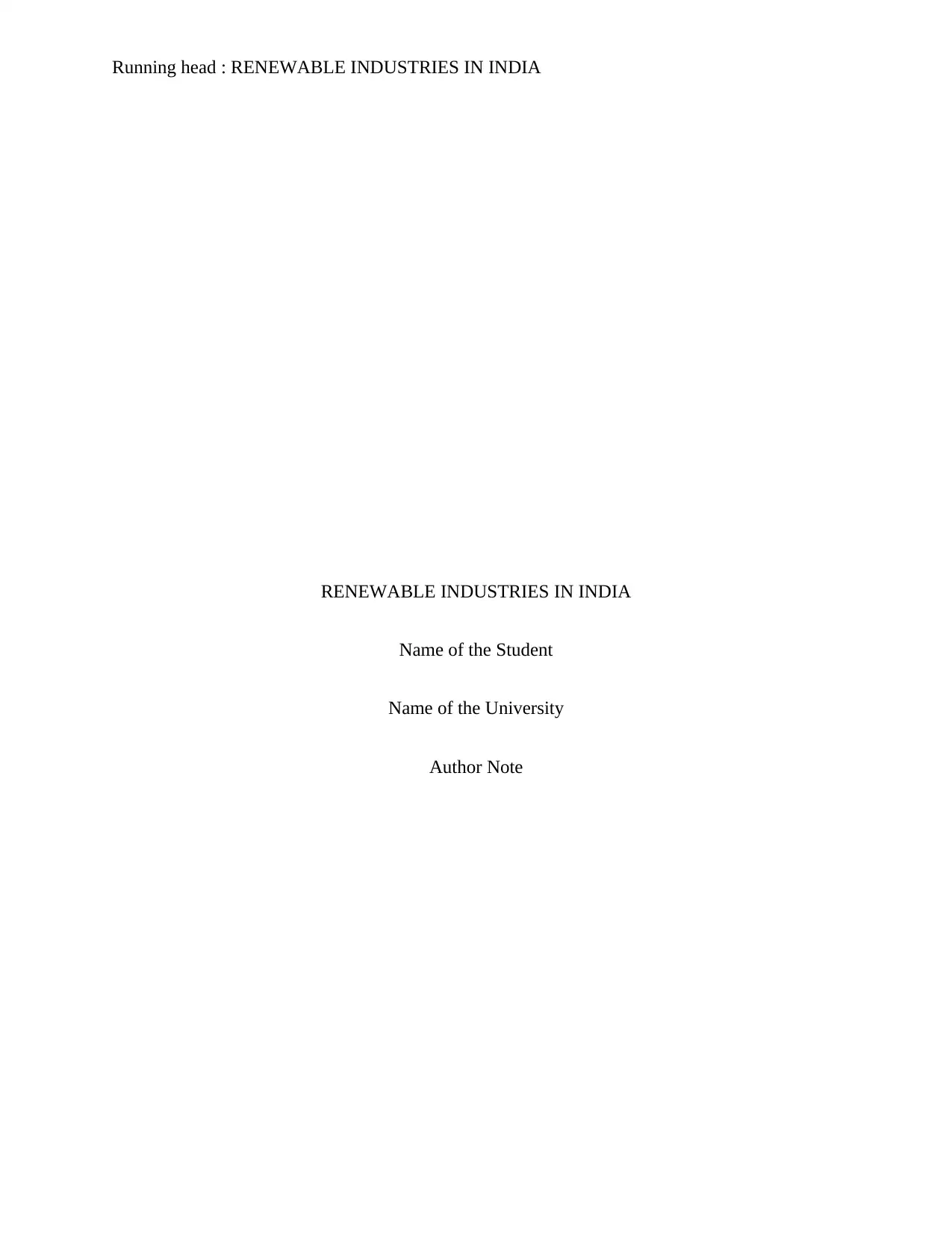
Running head : RENEWABLE INDUSTRIES IN INDIA
RENEWABLE INDUSTRIES IN INDIA
Name of the Student
Name of the University
Author Note
RENEWABLE INDUSTRIES IN INDIA
Name of the Student
Name of the University
Author Note
Paraphrase This Document
Need a fresh take? Get an instant paraphrase of this document with our AI Paraphraser
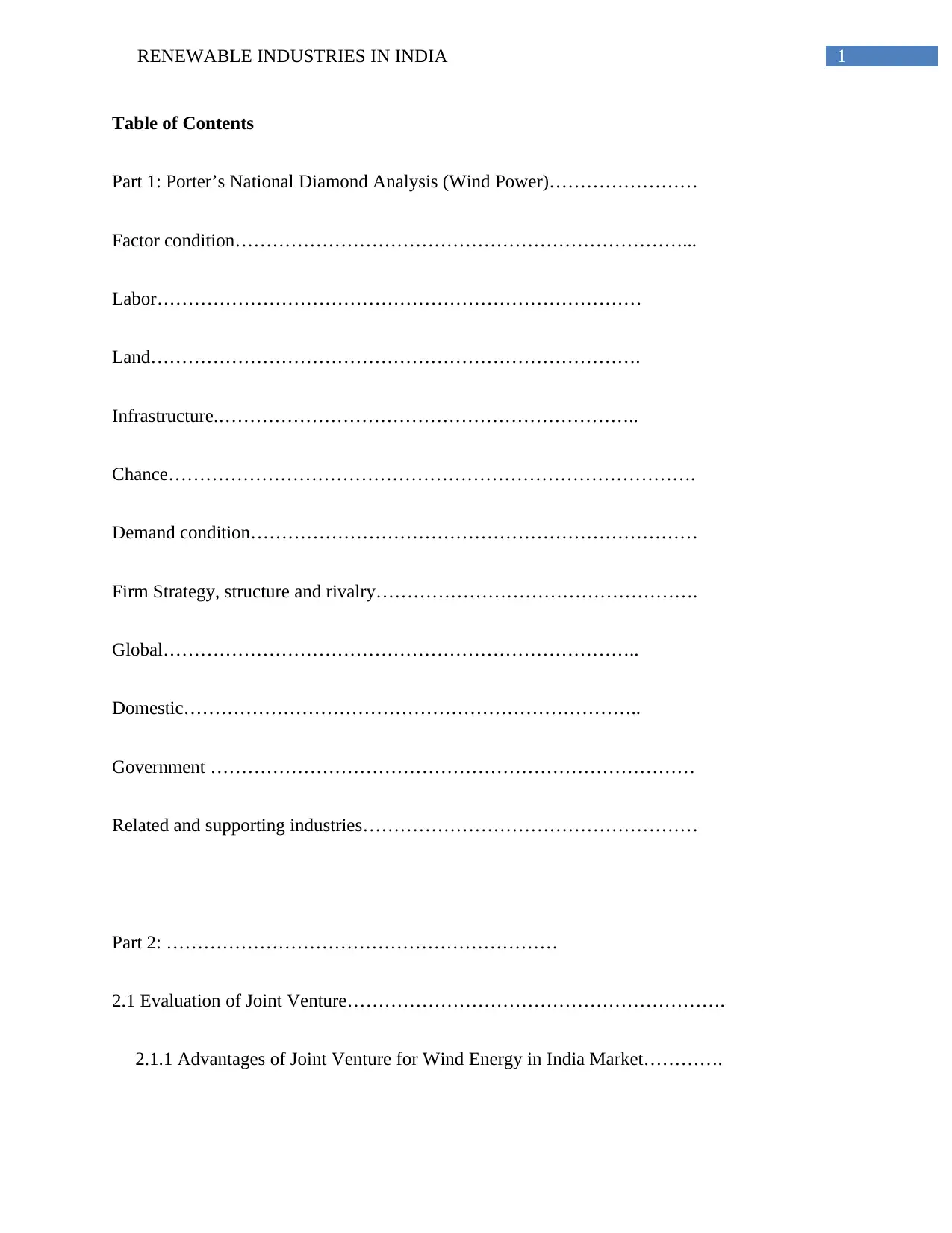
1RENEWABLE INDUSTRIES IN INDIA
Table of Contents
Part 1: Porter’s National Diamond Analysis (Wind Power)……………………
Factor condition………………………………………………………………...
Labor……………………………………………………………………
Land…………………………………………………………………….
Infrastructure.…………………………………………………………..
Chance………………………………………………………………………….
Demand condition………………………………………………………………
Firm Strategy, structure and rivalry…………………………………………….
Global…………………………………………………………………..
Domestic………………………………………………………………..
Government ……………………………………………………………………
Related and supporting industries………………………………………………
Part 2: ………………………………………………………
2.1 Evaluation of Joint Venture…………………………………………………….
2.1.1 Advantages of Joint Venture for Wind Energy in India Market………….
Table of Contents
Part 1: Porter’s National Diamond Analysis (Wind Power)……………………
Factor condition………………………………………………………………...
Labor……………………………………………………………………
Land…………………………………………………………………….
Infrastructure.…………………………………………………………..
Chance………………………………………………………………………….
Demand condition………………………………………………………………
Firm Strategy, structure and rivalry…………………………………………….
Global…………………………………………………………………..
Domestic………………………………………………………………..
Government ……………………………………………………………………
Related and supporting industries………………………………………………
Part 2: ………………………………………………………
2.1 Evaluation of Joint Venture…………………………………………………….
2.1.1 Advantages of Joint Venture for Wind Energy in India Market………….
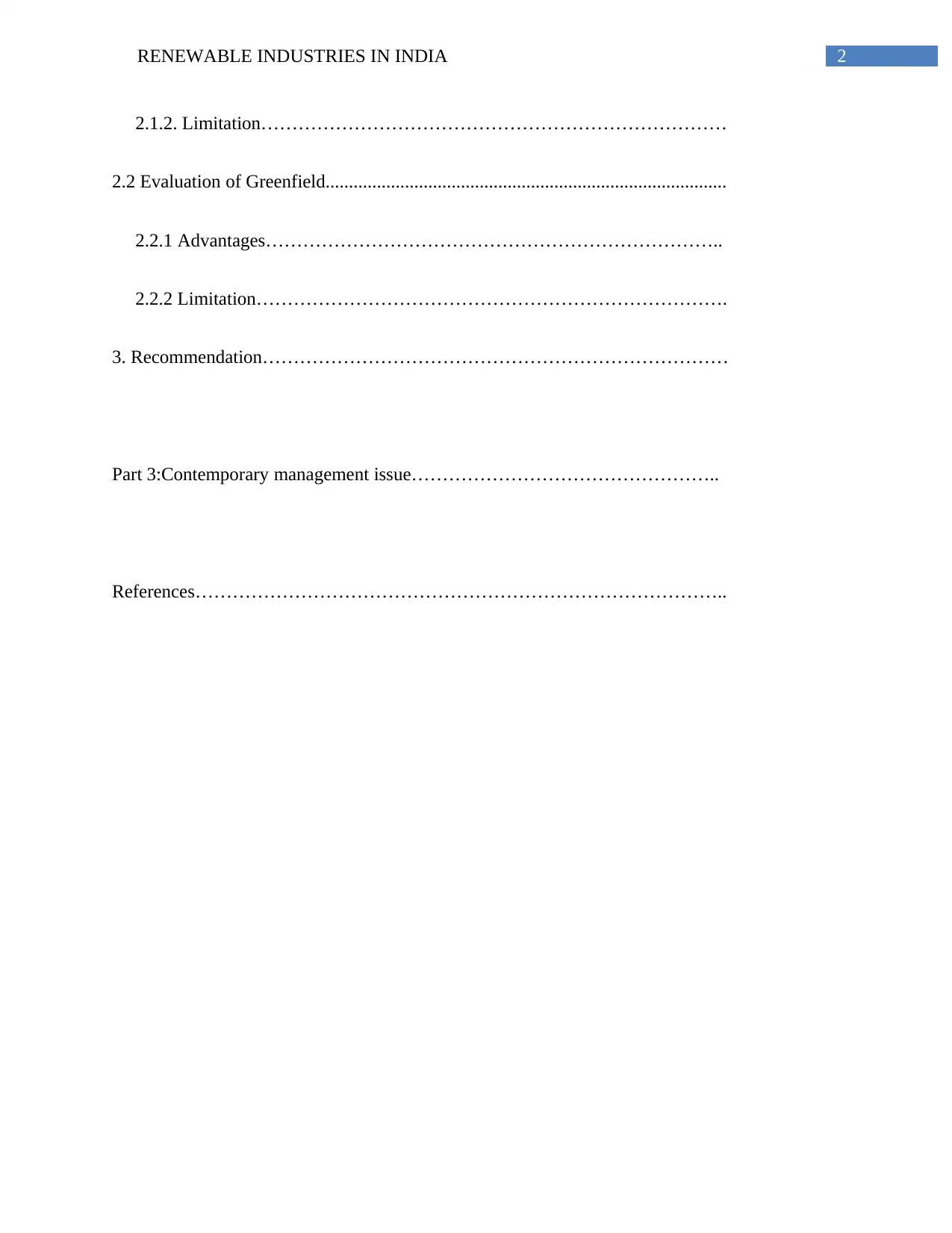
2RENEWABLE INDUSTRIES IN INDIA
2.1.2. Limitation…………………………………………………………………
2.2 Evaluation of Greenfield......................................................................................
2.2.1 Advantages………………………………………………………………..
2.2.2 Limitation………………………………………………………………….
3. Recommendation…………………………………………………………………
Part 3:Contemporary management issue…………………………………………..
References…………………………………………………………………………..
2.1.2. Limitation…………………………………………………………………
2.2 Evaluation of Greenfield......................................................................................
2.2.1 Advantages………………………………………………………………..
2.2.2 Limitation………………………………………………………………….
3. Recommendation…………………………………………………………………
Part 3:Contemporary management issue…………………………………………..
References…………………………………………………………………………..
⊘ This is a preview!⊘
Do you want full access?
Subscribe today to unlock all pages.

Trusted by 1+ million students worldwide
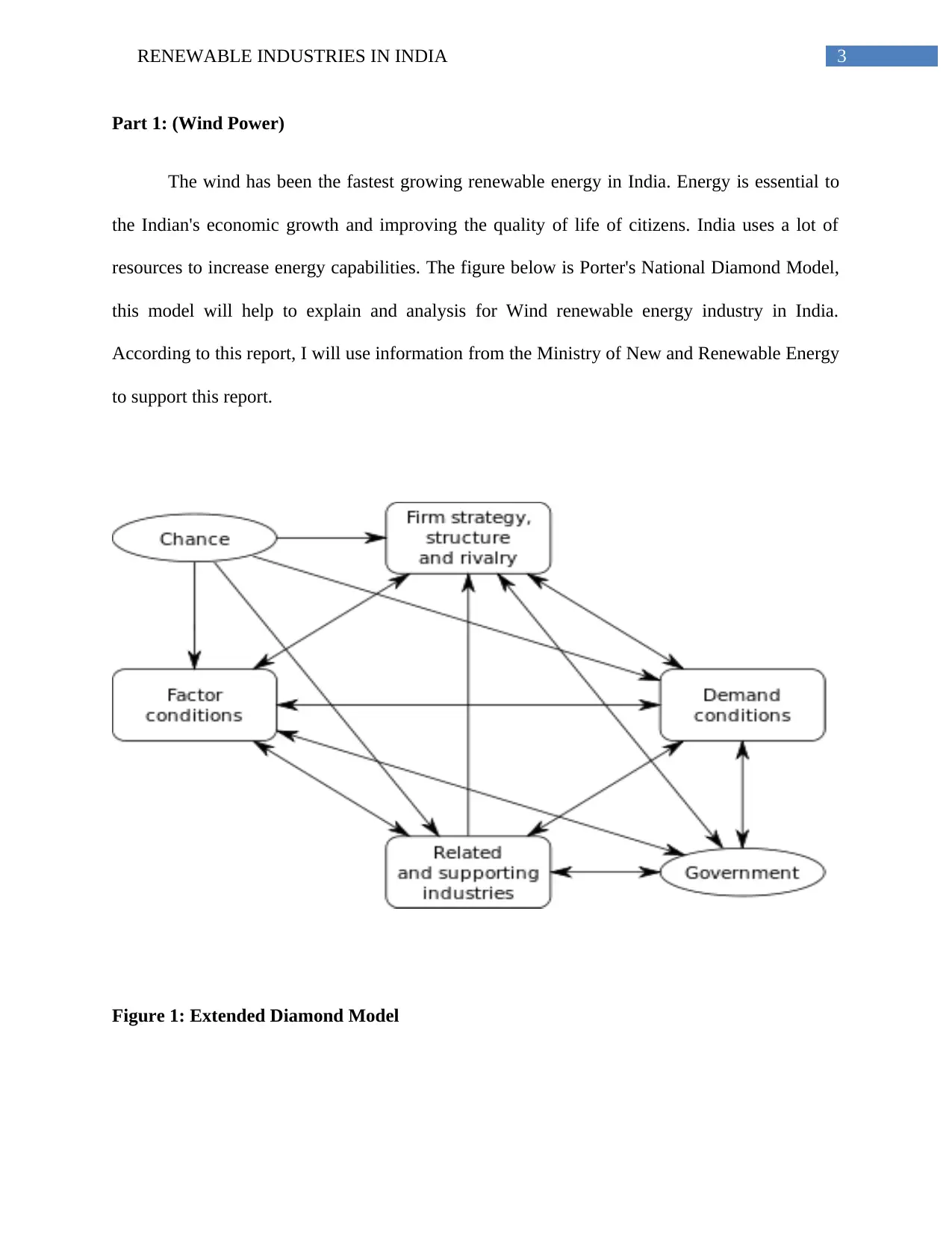
3RENEWABLE INDUSTRIES IN INDIA
Part 1: (Wind Power)
The wind has been the fastest growing renewable energy in India. Energy is essential to
the Indian's economic growth and improving the quality of life of citizens. India uses a lot of
resources to increase energy capabilities. The figure below is Porter's National Diamond Model,
this model will help to explain and analysis for Wind renewable energy industry in India.
According to this report, I will use information from the Ministry of New and Renewable Energy
to support this report.
Figure 1: Extended Diamond Model
Part 1: (Wind Power)
The wind has been the fastest growing renewable energy in India. Energy is essential to
the Indian's economic growth and improving the quality of life of citizens. India uses a lot of
resources to increase energy capabilities. The figure below is Porter's National Diamond Model,
this model will help to explain and analysis for Wind renewable energy industry in India.
According to this report, I will use information from the Ministry of New and Renewable Energy
to support this report.
Figure 1: Extended Diamond Model
Paraphrase This Document
Need a fresh take? Get an instant paraphrase of this document with our AI Paraphraser
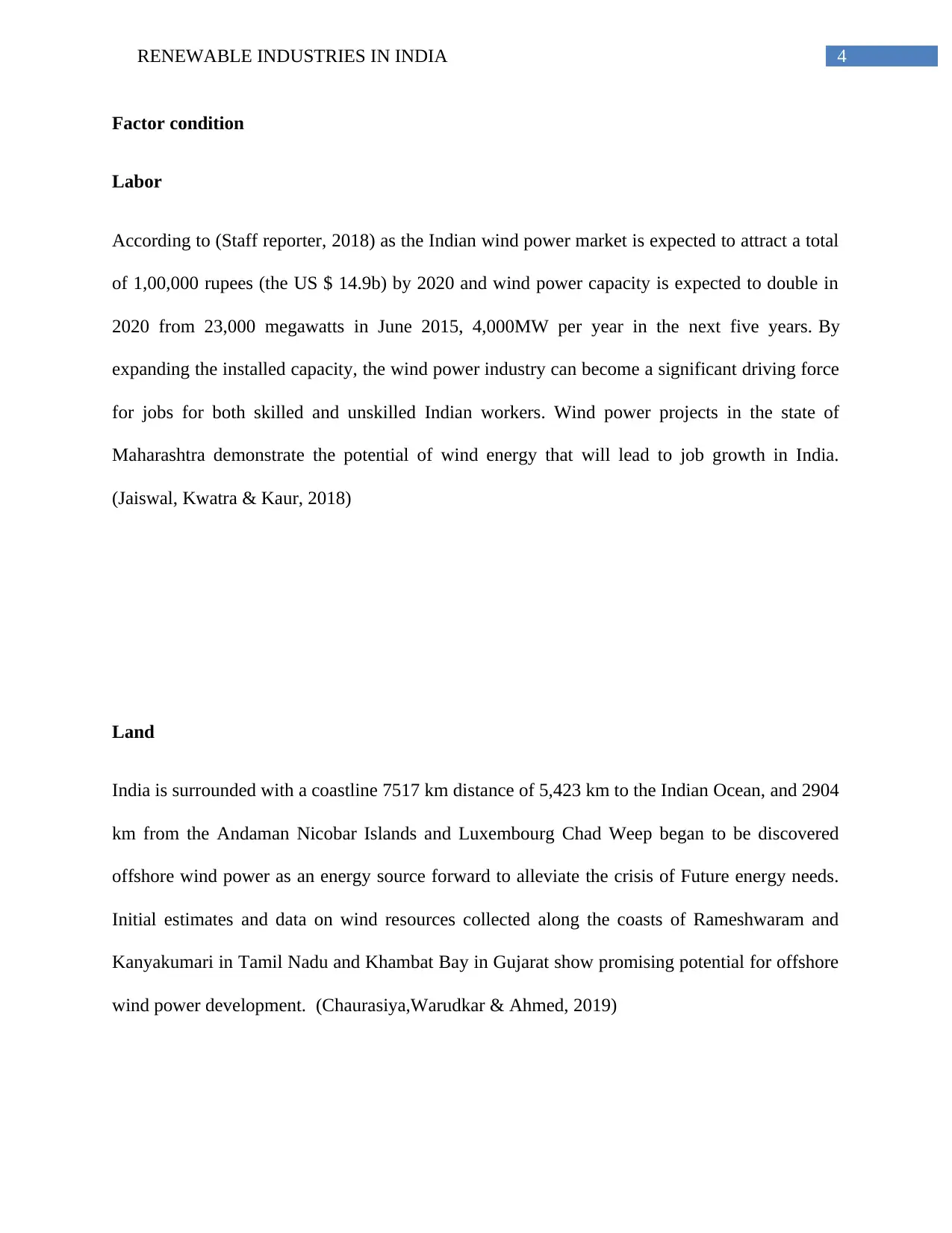
4RENEWABLE INDUSTRIES IN INDIA
Factor condition
Labor
According to (Staff reporter, 2018) as the Indian wind power market is expected to attract a total
of 1,00,000 rupees (the US $ 14.9b) by 2020 and wind power capacity is expected to double in
2020 from 23,000 megawatts in June 2015, 4,000MW per year in the next five years. By
expanding the installed capacity, the wind power industry can become a significant driving force
for jobs for both skilled and unskilled Indian workers. Wind power projects in the state of
Maharashtra demonstrate the potential of wind energy that will lead to job growth in India.
(Jaiswal, Kwatra & Kaur, 2018)
Land
India is surrounded with a coastline 7517 km distance of 5,423 km to the Indian Ocean, and 2904
km from the Andaman Nicobar Islands and Luxembourg Chad Weep began to be discovered
offshore wind power as an energy source forward to alleviate the crisis of Future energy needs.
Initial estimates and data on wind resources collected along the coasts of Rameshwaram and
Kanyakumari in Tamil Nadu and Khambat Bay in Gujarat show promising potential for offshore
wind power development. (Chaurasiya,Warudkar & Ahmed, 2019)
Factor condition
Labor
According to (Staff reporter, 2018) as the Indian wind power market is expected to attract a total
of 1,00,000 rupees (the US $ 14.9b) by 2020 and wind power capacity is expected to double in
2020 from 23,000 megawatts in June 2015, 4,000MW per year in the next five years. By
expanding the installed capacity, the wind power industry can become a significant driving force
for jobs for both skilled and unskilled Indian workers. Wind power projects in the state of
Maharashtra demonstrate the potential of wind energy that will lead to job growth in India.
(Jaiswal, Kwatra & Kaur, 2018)
Land
India is surrounded with a coastline 7517 km distance of 5,423 km to the Indian Ocean, and 2904
km from the Andaman Nicobar Islands and Luxembourg Chad Weep began to be discovered
offshore wind power as an energy source forward to alleviate the crisis of Future energy needs.
Initial estimates and data on wind resources collected along the coasts of Rameshwaram and
Kanyakumari in Tamil Nadu and Khambat Bay in Gujarat show promising potential for offshore
wind power development. (Chaurasiya,Warudkar & Ahmed, 2019)
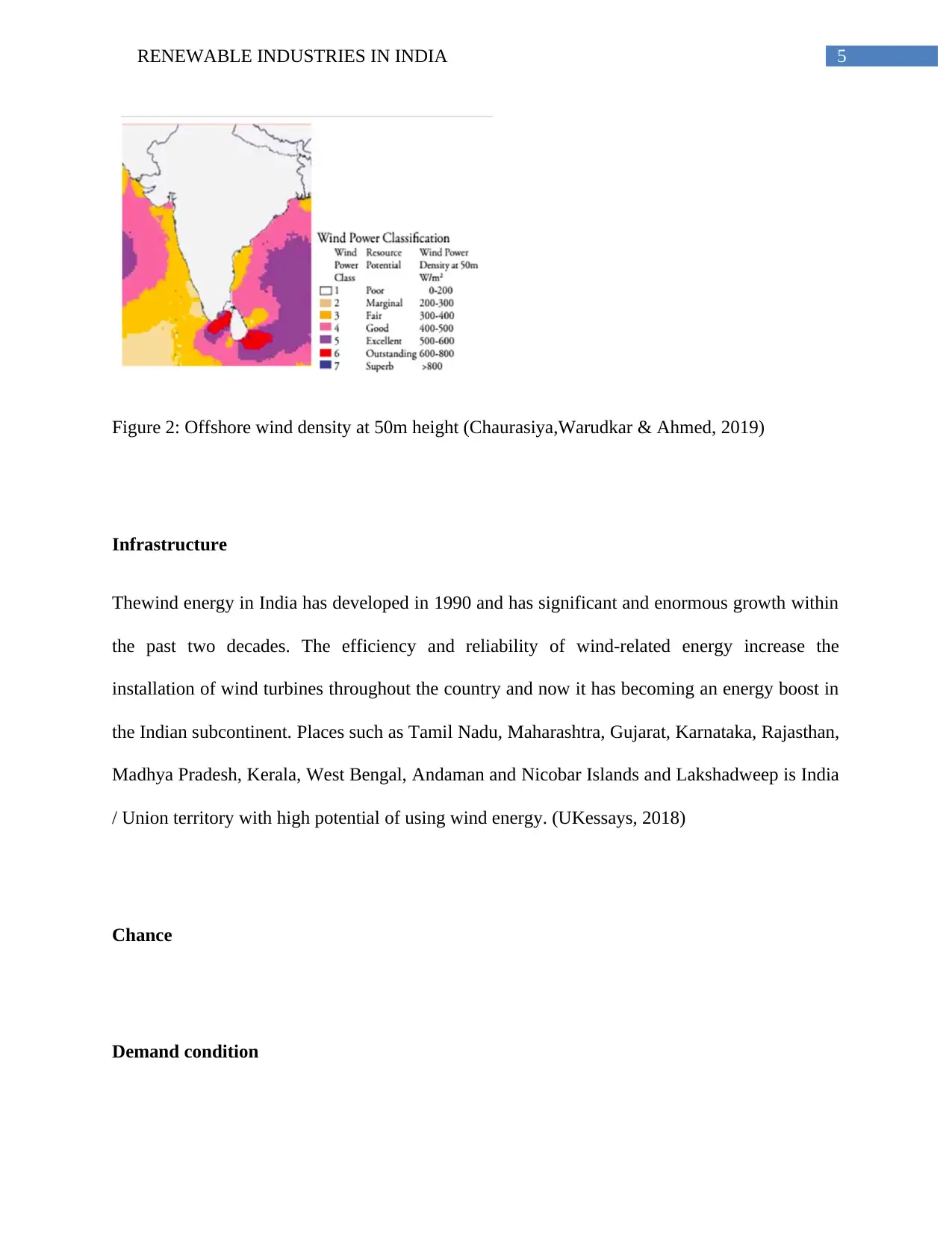
5RENEWABLE INDUSTRIES IN INDIA
Figure 2: Offshore wind density at 50m height (Chaurasiya,Warudkar & Ahmed, 2019)
Infrastructure
Thewind energy in India has developed in 1990 and has significant and enormous growth within
the past two decades. The efficiency and reliability of wind-related energy increase the
installation of wind turbines throughout the country and now it has becoming an energy boost in
the Indian subcontinent. Places such as Tamil Nadu, Maharashtra, Gujarat, Karnataka, Rajasthan,
Madhya Pradesh, Kerala, West Bengal, Andaman and Nicobar Islands and Lakshadweep is India
/ Union territory with high potential of using wind energy. (UKessays, 2018)
Chance
Demand condition
Figure 2: Offshore wind density at 50m height (Chaurasiya,Warudkar & Ahmed, 2019)
Infrastructure
Thewind energy in India has developed in 1990 and has significant and enormous growth within
the past two decades. The efficiency and reliability of wind-related energy increase the
installation of wind turbines throughout the country and now it has becoming an energy boost in
the Indian subcontinent. Places such as Tamil Nadu, Maharashtra, Gujarat, Karnataka, Rajasthan,
Madhya Pradesh, Kerala, West Bengal, Andaman and Nicobar Islands and Lakshadweep is India
/ Union territory with high potential of using wind energy. (UKessays, 2018)
Chance
Demand condition
⊘ This is a preview!⊘
Do you want full access?
Subscribe today to unlock all pages.

Trusted by 1+ million students worldwide
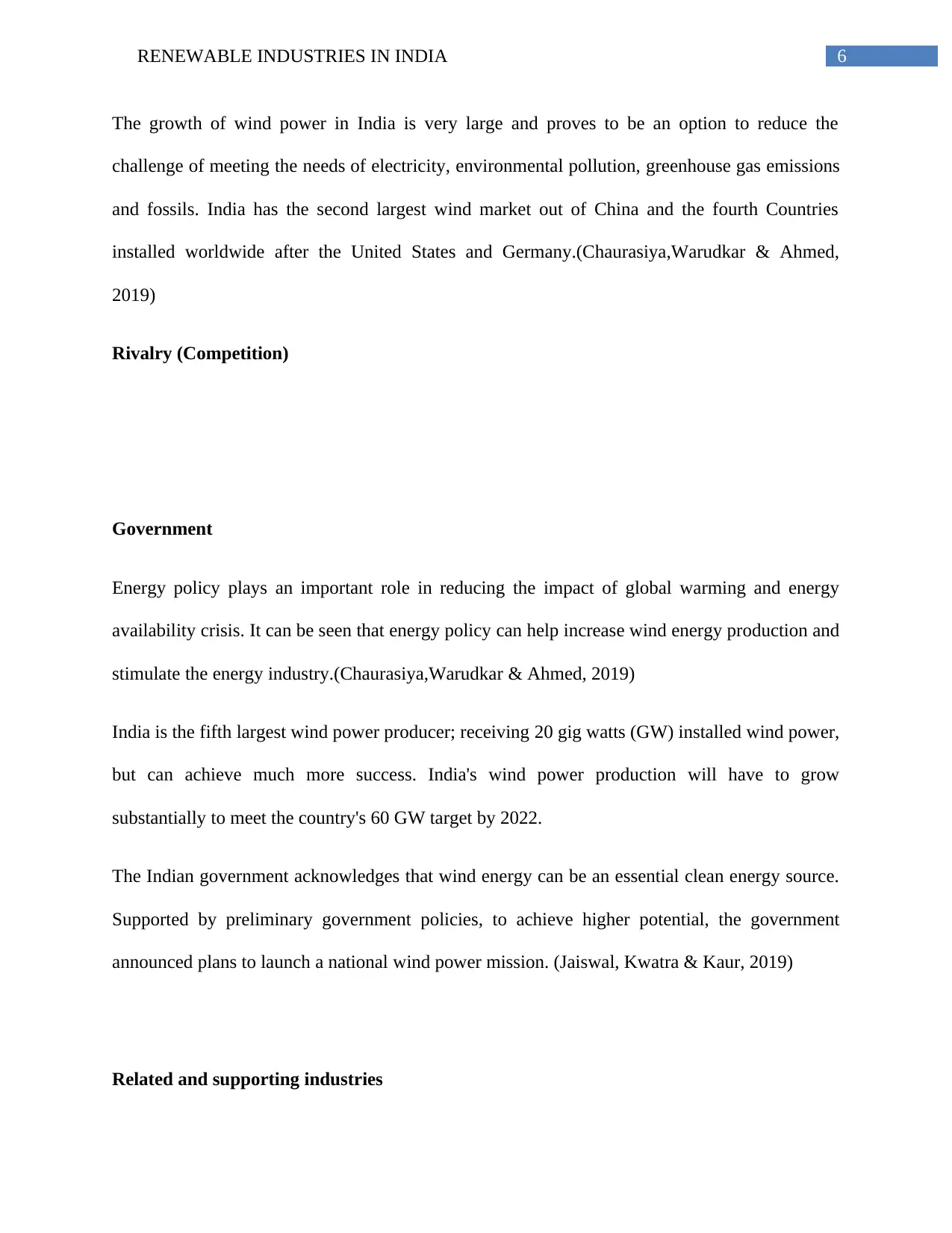
6RENEWABLE INDUSTRIES IN INDIA
The growth of wind power in India is very large and proves to be an option to reduce the
challenge of meeting the needs of electricity, environmental pollution, greenhouse gas emissions
and fossils. India has the second largest wind market out of China and the fourth Countries
installed worldwide after the United States and Germany.(Chaurasiya,Warudkar & Ahmed,
2019)
Rivalry (Competition)
Government
Energy policy plays an important role in reducing the impact of global warming and energy
availability crisis. It can be seen that energy policy can help increase wind energy production and
stimulate the energy industry.(Chaurasiya,Warudkar & Ahmed, 2019)
India is the fifth largest wind power producer; receiving 20 gig watts (GW) installed wind power,
but can achieve much more success. India's wind power production will have to grow
substantially to meet the country's 60 GW target by 2022.
The Indian government acknowledges that wind energy can be an essential clean energy source.
Supported by preliminary government policies, to achieve higher potential, the government
announced plans to launch a national wind power mission. (Jaiswal, Kwatra & Kaur, 2019)
Related and supporting industries
The growth of wind power in India is very large and proves to be an option to reduce the
challenge of meeting the needs of electricity, environmental pollution, greenhouse gas emissions
and fossils. India has the second largest wind market out of China and the fourth Countries
installed worldwide after the United States and Germany.(Chaurasiya,Warudkar & Ahmed,
2019)
Rivalry (Competition)
Government
Energy policy plays an important role in reducing the impact of global warming and energy
availability crisis. It can be seen that energy policy can help increase wind energy production and
stimulate the energy industry.(Chaurasiya,Warudkar & Ahmed, 2019)
India is the fifth largest wind power producer; receiving 20 gig watts (GW) installed wind power,
but can achieve much more success. India's wind power production will have to grow
substantially to meet the country's 60 GW target by 2022.
The Indian government acknowledges that wind energy can be an essential clean energy source.
Supported by preliminary government policies, to achieve higher potential, the government
announced plans to launch a national wind power mission. (Jaiswal, Kwatra & Kaur, 2019)
Related and supporting industries
Paraphrase This Document
Need a fresh take? Get an instant paraphrase of this document with our AI Paraphraser
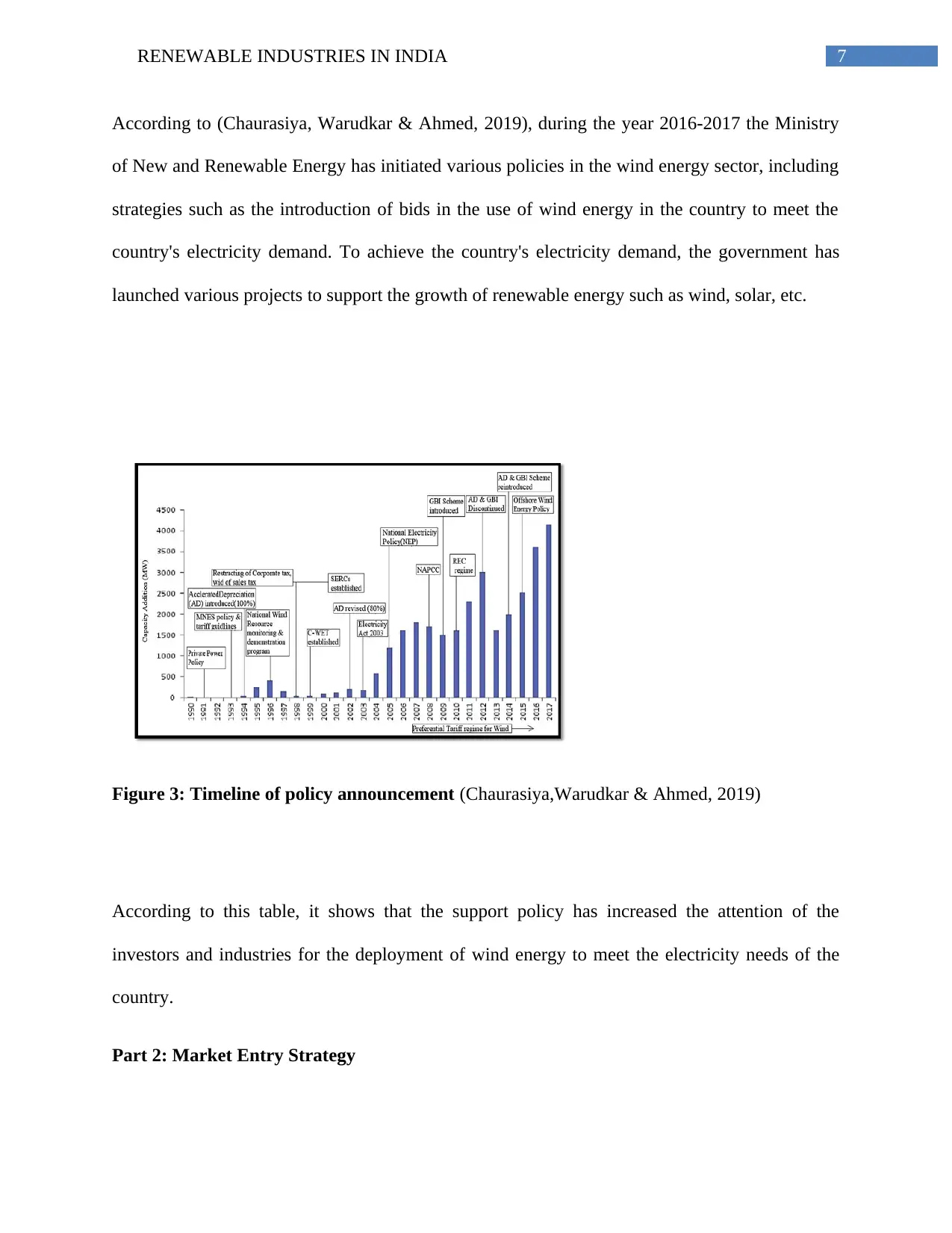
7RENEWABLE INDUSTRIES IN INDIA
According to (Chaurasiya, Warudkar & Ahmed, 2019), during the year 2016-2017 the Ministry
of New and Renewable Energy has initiated various policies in the wind energy sector, including
strategies such as the introduction of bids in the use of wind energy in the country to meet the
country's electricity demand. To achieve the country's electricity demand, the government has
launched various projects to support the growth of renewable energy such as wind, solar, etc.
Figure 3: Timeline of policy announcement (Chaurasiya,Warudkar & Ahmed, 2019)
According to this table, it shows that the support policy has increased the attention of the
investors and industries for the deployment of wind energy to meet the electricity needs of the
country.
Part 2: Market Entry Strategy
According to (Chaurasiya, Warudkar & Ahmed, 2019), during the year 2016-2017 the Ministry
of New and Renewable Energy has initiated various policies in the wind energy sector, including
strategies such as the introduction of bids in the use of wind energy in the country to meet the
country's electricity demand. To achieve the country's electricity demand, the government has
launched various projects to support the growth of renewable energy such as wind, solar, etc.
Figure 3: Timeline of policy announcement (Chaurasiya,Warudkar & Ahmed, 2019)
According to this table, it shows that the support policy has increased the attention of the
investors and industries for the deployment of wind energy to meet the electricity needs of the
country.
Part 2: Market Entry Strategy
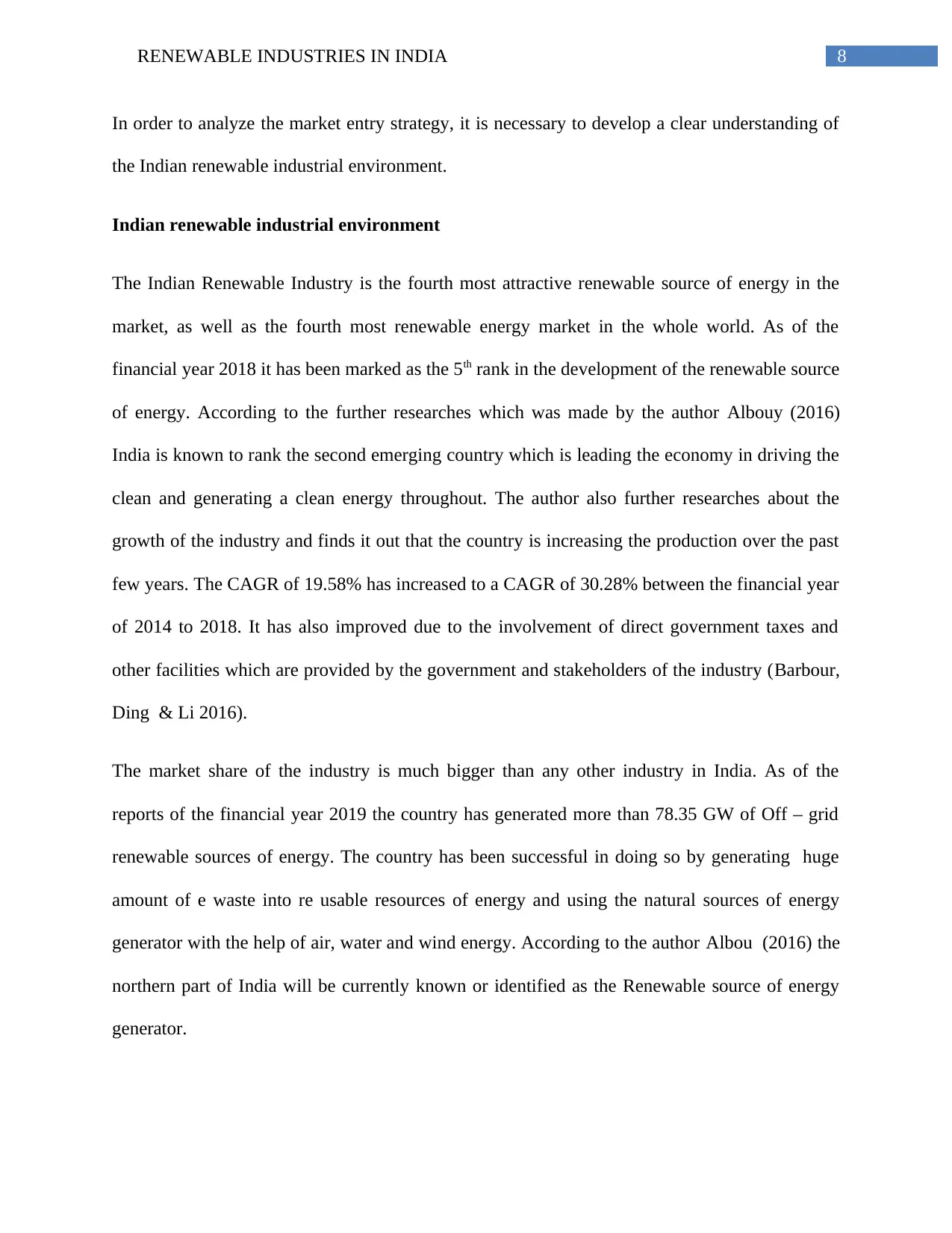
8RENEWABLE INDUSTRIES IN INDIA
In order to analyze the market entry strategy, it is necessary to develop a clear understanding of
the Indian renewable industrial environment.
Indian renewable industrial environment
The Indian Renewable Industry is the fourth most attractive renewable source of energy in the
market, as well as the fourth most renewable energy market in the whole world. As of the
financial year 2018 it has been marked as the 5th rank in the development of the renewable source
of energy. According to the further researches which was made by the author Albouy (2016)
India is known to rank the second emerging country which is leading the economy in driving the
clean and generating a clean energy throughout. The author also further researches about the
growth of the industry and finds it out that the country is increasing the production over the past
few years. The CAGR of 19.58% has increased to a CAGR of 30.28% between the financial year
of 2014 to 2018. It has also improved due to the involvement of direct government taxes and
other facilities which are provided by the government and stakeholders of the industry (Barbour,
Ding & Li 2016).
The market share of the industry is much bigger than any other industry in India. As of the
reports of the financial year 2019 the country has generated more than 78.35 GW of Off – grid
renewable sources of energy. The country has been successful in doing so by generating huge
amount of e waste into re usable resources of energy and using the natural sources of energy
generator with the help of air, water and wind energy. According to the author Albou (2016) the
northern part of India will be currently known or identified as the Renewable source of energy
generator.
In order to analyze the market entry strategy, it is necessary to develop a clear understanding of
the Indian renewable industrial environment.
Indian renewable industrial environment
The Indian Renewable Industry is the fourth most attractive renewable source of energy in the
market, as well as the fourth most renewable energy market in the whole world. As of the
financial year 2018 it has been marked as the 5th rank in the development of the renewable source
of energy. According to the further researches which was made by the author Albouy (2016)
India is known to rank the second emerging country which is leading the economy in driving the
clean and generating a clean energy throughout. The author also further researches about the
growth of the industry and finds it out that the country is increasing the production over the past
few years. The CAGR of 19.58% has increased to a CAGR of 30.28% between the financial year
of 2014 to 2018. It has also improved due to the involvement of direct government taxes and
other facilities which are provided by the government and stakeholders of the industry (Barbour,
Ding & Li 2016).
The market share of the industry is much bigger than any other industry in India. As of the
reports of the financial year 2019 the country has generated more than 78.35 GW of Off – grid
renewable sources of energy. The country has been successful in doing so by generating huge
amount of e waste into re usable resources of energy and using the natural sources of energy
generator with the help of air, water and wind energy. According to the author Albou (2016) the
northern part of India will be currently known or identified as the Renewable source of energy
generator.
⊘ This is a preview!⊘
Do you want full access?
Subscribe today to unlock all pages.

Trusted by 1+ million students worldwide
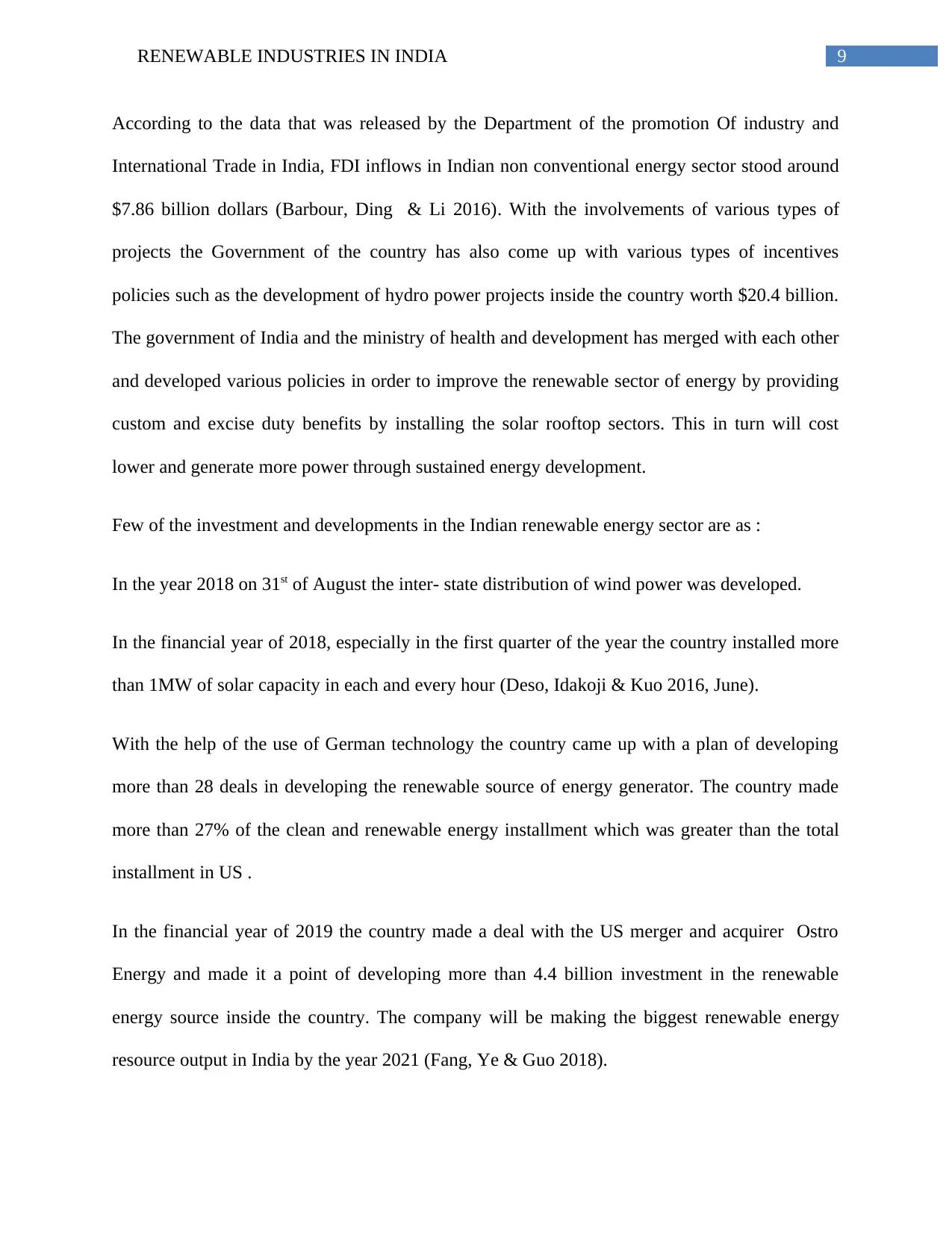
9RENEWABLE INDUSTRIES IN INDIA
According to the data that was released by the Department of the promotion Of industry and
International Trade in India, FDI inflows in Indian non conventional energy sector stood around
$7.86 billion dollars (Barbour, Ding & Li 2016). With the involvements of various types of
projects the Government of the country has also come up with various types of incentives
policies such as the development of hydro power projects inside the country worth $20.4 billion.
The government of India and the ministry of health and development has merged with each other
and developed various policies in order to improve the renewable sector of energy by providing
custom and excise duty benefits by installing the solar rooftop sectors. This in turn will cost
lower and generate more power through sustained energy development.
Few of the investment and developments in the Indian renewable energy sector are as :
In the year 2018 on 31st of August the inter- state distribution of wind power was developed.
In the financial year of 2018, especially in the first quarter of the year the country installed more
than 1MW of solar capacity in each and every hour (Deso, Idakoji & Kuo 2016, June).
With the help of the use of German technology the country came up with a plan of developing
more than 28 deals in developing the renewable source of energy generator. The country made
more than 27% of the clean and renewable energy installment which was greater than the total
installment in US .
In the financial year of 2019 the country made a deal with the US merger and acquirer Ostro
Energy and made it a point of developing more than 4.4 billion investment in the renewable
energy source inside the country. The company will be making the biggest renewable energy
resource output in India by the year 2021 (Fang, Ye & Guo 2018).
According to the data that was released by the Department of the promotion Of industry and
International Trade in India, FDI inflows in Indian non conventional energy sector stood around
$7.86 billion dollars (Barbour, Ding & Li 2016). With the involvements of various types of
projects the Government of the country has also come up with various types of incentives
policies such as the development of hydro power projects inside the country worth $20.4 billion.
The government of India and the ministry of health and development has merged with each other
and developed various policies in order to improve the renewable sector of energy by providing
custom and excise duty benefits by installing the solar rooftop sectors. This in turn will cost
lower and generate more power through sustained energy development.
Few of the investment and developments in the Indian renewable energy sector are as :
In the year 2018 on 31st of August the inter- state distribution of wind power was developed.
In the financial year of 2018, especially in the first quarter of the year the country installed more
than 1MW of solar capacity in each and every hour (Deso, Idakoji & Kuo 2016, June).
With the help of the use of German technology the country came up with a plan of developing
more than 28 deals in developing the renewable source of energy generator. The country made
more than 27% of the clean and renewable energy installment which was greater than the total
installment in US .
In the financial year of 2019 the country made a deal with the US merger and acquirer Ostro
Energy and made it a point of developing more than 4.4 billion investment in the renewable
energy source inside the country. The company will be making the biggest renewable energy
resource output in India by the year 2021 (Fang, Ye & Guo 2018).
Paraphrase This Document
Need a fresh take? Get an instant paraphrase of this document with our AI Paraphraser
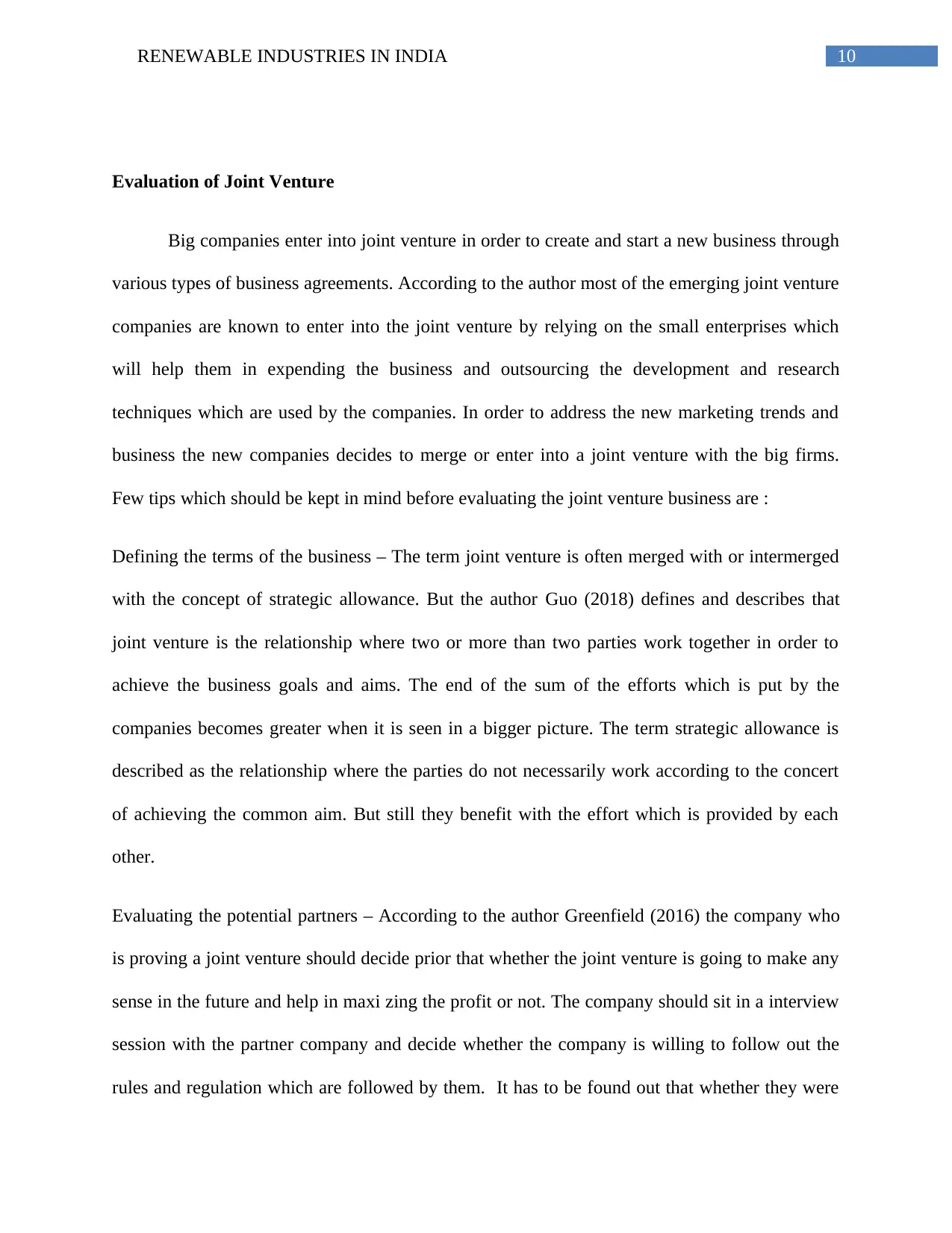
10RENEWABLE INDUSTRIES IN INDIA
Evaluation of Joint Venture
Big companies enter into joint venture in order to create and start a new business through
various types of business agreements. According to the author most of the emerging joint venture
companies are known to enter into the joint venture by relying on the small enterprises which
will help them in expending the business and outsourcing the development and research
techniques which are used by the companies. In order to address the new marketing trends and
business the new companies decides to merge or enter into a joint venture with the big firms.
Few tips which should be kept in mind before evaluating the joint venture business are :
Defining the terms of the business – The term joint venture is often merged with or intermerged
with the concept of strategic allowance. But the author Guo (2018) defines and describes that
joint venture is the relationship where two or more than two parties work together in order to
achieve the business goals and aims. The end of the sum of the efforts which is put by the
companies becomes greater when it is seen in a bigger picture. The term strategic allowance is
described as the relationship where the parties do not necessarily work according to the concert
of achieving the common aim. But still they benefit with the effort which is provided by each
other.
Evaluating the potential partners – According to the author Greenfield (2016) the company who
is proving a joint venture should decide prior that whether the joint venture is going to make any
sense in the future and help in maxi zing the profit or not. The company should sit in a interview
session with the partner company and decide whether the company is willing to follow out the
rules and regulation which are followed by them. It has to be found out that whether they were
Evaluation of Joint Venture
Big companies enter into joint venture in order to create and start a new business through
various types of business agreements. According to the author most of the emerging joint venture
companies are known to enter into the joint venture by relying on the small enterprises which
will help them in expending the business and outsourcing the development and research
techniques which are used by the companies. In order to address the new marketing trends and
business the new companies decides to merge or enter into a joint venture with the big firms.
Few tips which should be kept in mind before evaluating the joint venture business are :
Defining the terms of the business – The term joint venture is often merged with or intermerged
with the concept of strategic allowance. But the author Guo (2018) defines and describes that
joint venture is the relationship where two or more than two parties work together in order to
achieve the business goals and aims. The end of the sum of the efforts which is put by the
companies becomes greater when it is seen in a bigger picture. The term strategic allowance is
described as the relationship where the parties do not necessarily work according to the concert
of achieving the common aim. But still they benefit with the effort which is provided by each
other.
Evaluating the potential partners – According to the author Greenfield (2016) the company who
is proving a joint venture should decide prior that whether the joint venture is going to make any
sense in the future and help in maxi zing the profit or not. The company should sit in a interview
session with the partner company and decide whether the company is willing to follow out the
rules and regulation which are followed by them. It has to be found out that whether they were
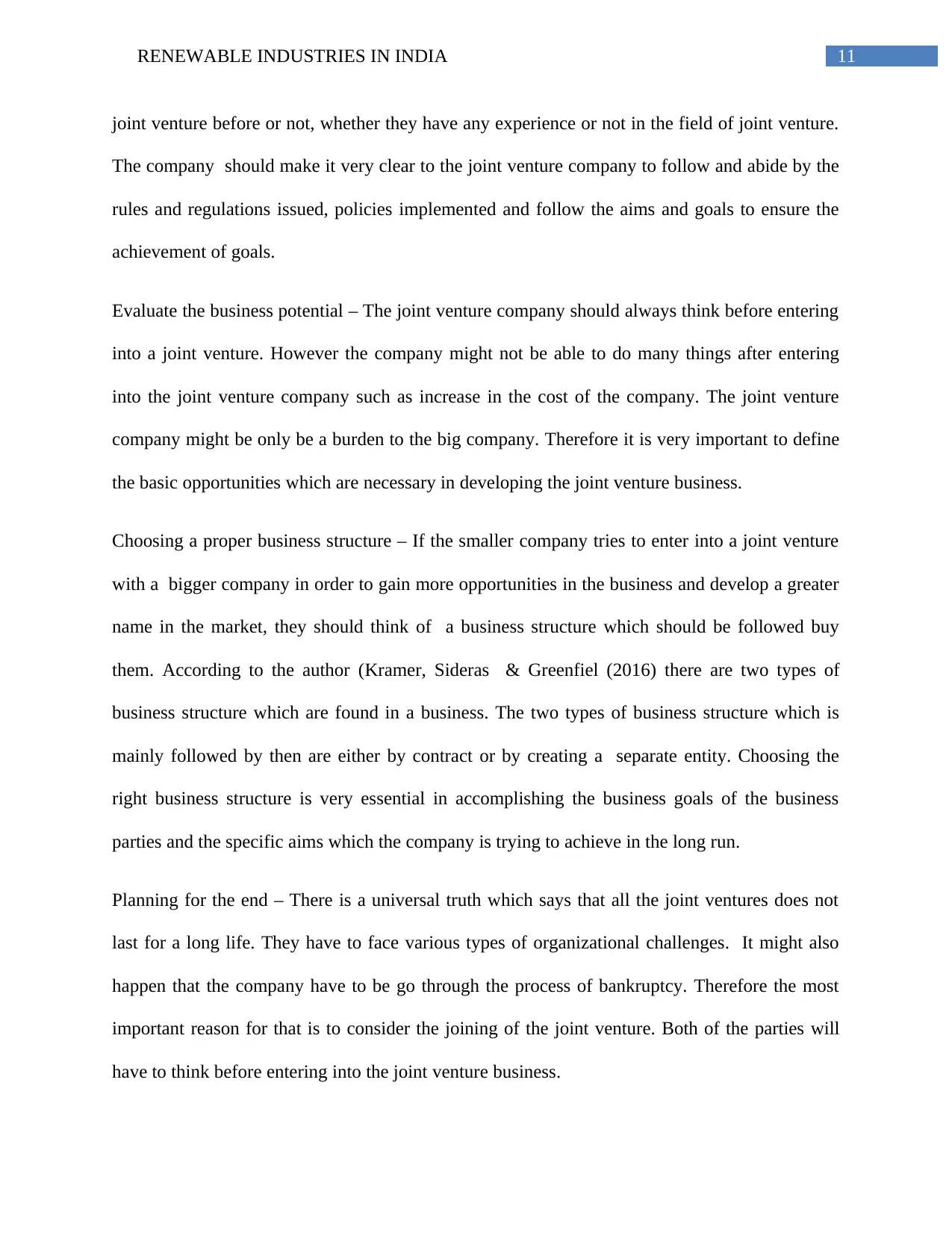
11RENEWABLE INDUSTRIES IN INDIA
joint venture before or not, whether they have any experience or not in the field of joint venture.
The company should make it very clear to the joint venture company to follow and abide by the
rules and regulations issued, policies implemented and follow the aims and goals to ensure the
achievement of goals.
Evaluate the business potential – The joint venture company should always think before entering
into a joint venture. However the company might not be able to do many things after entering
into the joint venture company such as increase in the cost of the company. The joint venture
company might be only be a burden to the big company. Therefore it is very important to define
the basic opportunities which are necessary in developing the joint venture business.
Choosing a proper business structure – If the smaller company tries to enter into a joint venture
with a bigger company in order to gain more opportunities in the business and develop a greater
name in the market, they should think of a business structure which should be followed buy
them. According to the author (Kramer, Sideras & Greenfiel (2016) there are two types of
business structure which are found in a business. The two types of business structure which is
mainly followed by then are either by contract or by creating a separate entity. Choosing the
right business structure is very essential in accomplishing the business goals of the business
parties and the specific aims which the company is trying to achieve in the long run.
Planning for the end – There is a universal truth which says that all the joint ventures does not
last for a long life. They have to face various types of organizational challenges. It might also
happen that the company have to be go through the process of bankruptcy. Therefore the most
important reason for that is to consider the joining of the joint venture. Both of the parties will
have to think before entering into the joint venture business.
joint venture before or not, whether they have any experience or not in the field of joint venture.
The company should make it very clear to the joint venture company to follow and abide by the
rules and regulations issued, policies implemented and follow the aims and goals to ensure the
achievement of goals.
Evaluate the business potential – The joint venture company should always think before entering
into a joint venture. However the company might not be able to do many things after entering
into the joint venture company such as increase in the cost of the company. The joint venture
company might be only be a burden to the big company. Therefore it is very important to define
the basic opportunities which are necessary in developing the joint venture business.
Choosing a proper business structure – If the smaller company tries to enter into a joint venture
with a bigger company in order to gain more opportunities in the business and develop a greater
name in the market, they should think of a business structure which should be followed buy
them. According to the author (Kramer, Sideras & Greenfiel (2016) there are two types of
business structure which are found in a business. The two types of business structure which is
mainly followed by then are either by contract or by creating a separate entity. Choosing the
right business structure is very essential in accomplishing the business goals of the business
parties and the specific aims which the company is trying to achieve in the long run.
Planning for the end – There is a universal truth which says that all the joint ventures does not
last for a long life. They have to face various types of organizational challenges. It might also
happen that the company have to be go through the process of bankruptcy. Therefore the most
important reason for that is to consider the joining of the joint venture. Both of the parties will
have to think before entering into the joint venture business.
⊘ This is a preview!⊘
Do you want full access?
Subscribe today to unlock all pages.

Trusted by 1+ million students worldwide
1 out of 21
Your All-in-One AI-Powered Toolkit for Academic Success.
+13062052269
info@desklib.com
Available 24*7 on WhatsApp / Email
![[object Object]](/_next/static/media/star-bottom.7253800d.svg)
Unlock your academic potential
Copyright © 2020–2025 A2Z Services. All Rights Reserved. Developed and managed by ZUCOL.